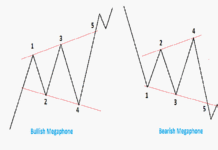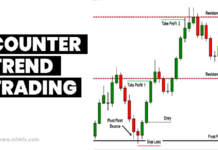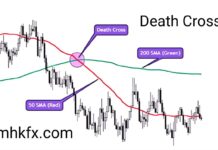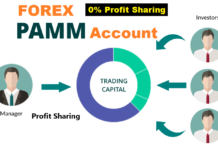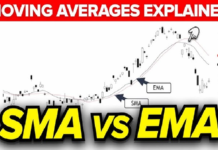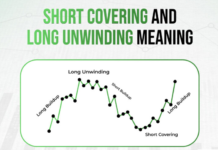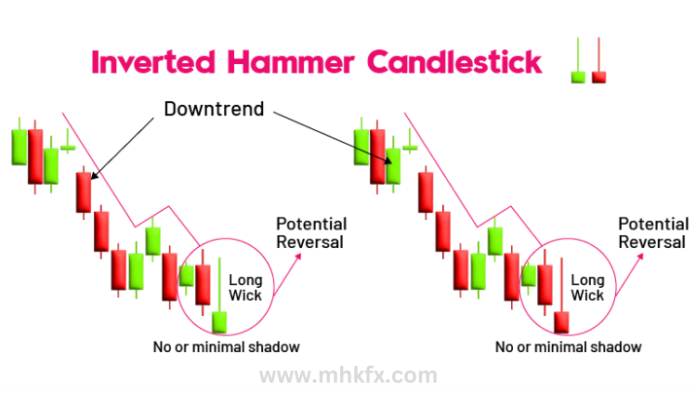
The Inverted Hammer candle is a notable pattern in technical analysis, signaling a potential reversal of a downtrend. For traders and investors, recognizing and understanding this pattern can provide valuable insights into market behavior and help pinpoint profitable entry points during transitions in market sentiment. This article delves into the characteristics, formation, and practical use of the Inverted Hammer candle, shedding light on how it can be effectively used in trading strategies.
What is the Inverted Hammer Candle?
The Inverted Hammer is a single-candle pattern that appears after a downtrend, suggesting that selling pressure might be nearing exhaustion, and the bulls could be preparing to regain control. It has a distinct visual structure:
- Small body: The body is small, either bullish (green/white) or bearish (red/black), indicating a minimal price difference between the open and close.
- Long upper shadow: The upper shadow is usually at least twice the size of the body, reflecting strong intraday buying pressure that eventually loses momentum.
- Little or no lower shadow: The absence of a lower shadow shows that the market did not push significantly below the opening price.
This candlestick looks like an upside-down version of the Hammer candle, which is also a bullish reversal pattern.
Formation of the Inverted Hammer
The Inverted Hammer forms during a downtrend, typically at the bottom of a bearish move. It starts with selling pressure, leading to a low opening. However, during the trading session, buyers step in and push prices higher, creating a long upper wick. Despite the buyers not being able to sustain the rally, the fact that they could push prices higher hints at weakening seller dominance. The day ends with the price closing near the opening level, creating a small body.
The key feature of the Inverted Hammer is the buying interest at lower levels, suggesting that the tide could turn in favor of the bulls. However, while the Inverted Hammer hints at a potential reversal, confirmation is required from the subsequent candles.
Key Characteristics:
- Location in a downtrend: The Inverted Hammer must appear after a prolonged downtrend, as it signals a possible end to the bearish momentum.
- Long upper shadow: This indicates that bulls were able to push the price up significantly, even if temporarily.
- Small body: Reflects indecision in the market as neither buyers nor sellers had full control by the close of the session.
- Confirmation needed: For greater reliability, traders often wait for the next session to confirm the reversal, typically with a strong bullish candle.
Significance of the Inverted Hammer Candle
The Inverted Hammer is a valuable tool in technical analysis because it provides an early indication of a potential reversal. It signals that while bears were in control for a while, they may be losing their grip. The long upper shadow shows that buyers have the power to push prices higher, but they are not yet dominant. If the following day’s candle confirms the bullish reversal; usually with a gap up or a strong bullish candlestick. it suggests that a shift in sentiment is underway.
However, the Inverted Hammer should not be used in isolation. It is best employed in conjunction with other technical tools like trendlines, support and resistance levels, or momentum indicators like the Relative Strength Index (RSI) or Moving Averages. By combining it with these tools, traders can strengthen their analysis and improve their chances of identifying accurate trend reversals.
Why is Confirmation Crucial?
Without confirmation, an Inverted Hammer can result in false signals. For example, if the next candle is bearish, it could indicate a continuation of the downtrend, and the Inverted Hammer would be invalidated. For this reason, waiting for a bullish confirmation candle (e.g: a large green candle or a gap-up open) ensures that the reversal is more likely to hold.
Practical Example of an Inverted Hammer
Suppose a stock has been in a steady decline, and after several red candles, an Inverted Hammer forms near a significant support level. During the trading session, the price initially drops lower, but then buyers push it up, creating a long upper wick. While the price closes near the open, the presence of the upper wick hints at buying pressure.
On the following day, the stock opens higher and closes with a large green candle, confirming the bullish reversal. This would provide traders with a signal to enter long positions, expecting the trend to reverse and move upward.
Trading Strategies Using the Inverted Hammer
-
Entry Strategy
Once an Inverted Hammer forms at the bottom of a downtrend, traders typically wait for a confirmation candle before entering a position. A common approach is to enter a long trade when the next day opens higher or closes with a bullish candle. A stop-loss can be placed below the low of the Inverted Hammer to manage risk.
-
Using Support Levels
The pattern becomes more reliable when it forms near key support levels. Support zones often act as a floor where the price finds buying interest, so an Inverted Hammer near support can be an even stronger signal of a potential reversal.
-
Incorporating Momentum Indicators
Combining the Inverted Hammer with momentum indicators like the RSI can improve its effectiveness. If the RSI is showing oversold conditions at the time of the Inverted Hammer’s appearance, it increases the likelihood of a reversal.
Limitations of the Inverted Hammer
While the Inverted Hammer is a reliable reversal signal, it is not foolproof. Here are some limitations to keep in mind:
- False signals: Without confirmation, the Inverted Hammer may not lead to a reversal, especially if broader market conditions remain bearish.
- Requires a trend: The Inverted Hammer is only meaningful in the context of a downtrend. In a sideways or consolidating market, its significance diminishes.
- Confirmation needed: To avoid false signals, it’s essential to wait for a bullish follow-up candle.
Conclusion
The Inverted Hammer Candle is a powerful candlestick pattern that, when used correctly, can be a valuable tool in identifying potential bullish reversals. By understanding its structure and confirming its signals with other technical tools, traders can effectively incorporate it into their strategies. However, it’s essential to always wait for confirmation and use sound risk management practices, such as placing stop-losses, to ensure that the trading decisions are well-informed and protected from unexpected market movements.

